Effective Training and Coaching Strategies in the Modern Workplace
VerifiedAdded on 2021/04/21
|15
|2431
|51
Report
AI Summary
This report provides a comprehensive overview of training and coaching methodologies in the workplace. It begins by exploring the identification of training needs, utilizing methods like training needs analysis to pinpoint skill gaps and practical observations to assess employee capabilities. The report then delves into various training techniques, including e-learning, simulations, blended learning, and coaching, emphasizing their adaptability to modern work environments. It highlights the importance of understanding diverse learning styles (Accommodating, Diverging, Assimilating, Converging, Activists, Theorists, Pragmatists, Reflectors, and VAK) to tailor training effectively. The report discusses the evaluation of training effectiveness using Kirkpatrick's Four-Level Training Evaluation method and the maintenance of training records. Furthermore, the report transitions to coaching, outlining how to identify coaching needs through observation and models like the GROW model, and how to plan coaching sessions. It emphasizes the significance of feedback in coaching and describes evaluation methods, including frameworks by the Institute of Employment Studies, UK, to assess coaching effectiveness at individual and organizational levels. The report provides a template for a team training plan and a coaching plan template to illustrate practical application.
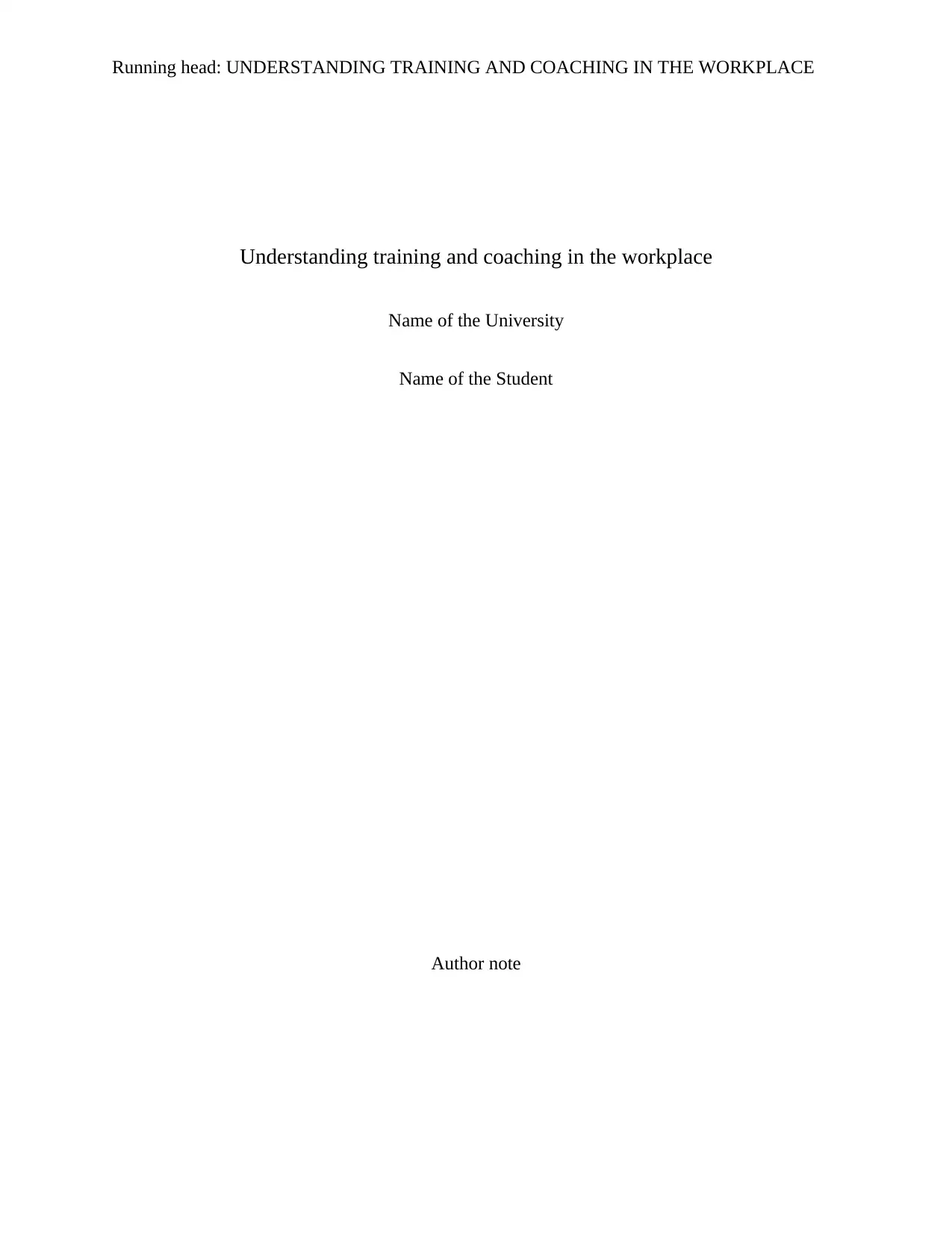
Running head: UNDERSTANDING TRAINING AND COACHING IN THE WORKPLACE
Understanding training and coaching in the workplace
Name of the University
Name of the Student
Author note
Understanding training and coaching in the workplace
Name of the University
Name of the Student
Author note
Paraphrase This Document
Need a fresh take? Get an instant paraphrase of this document with our AI Paraphraser
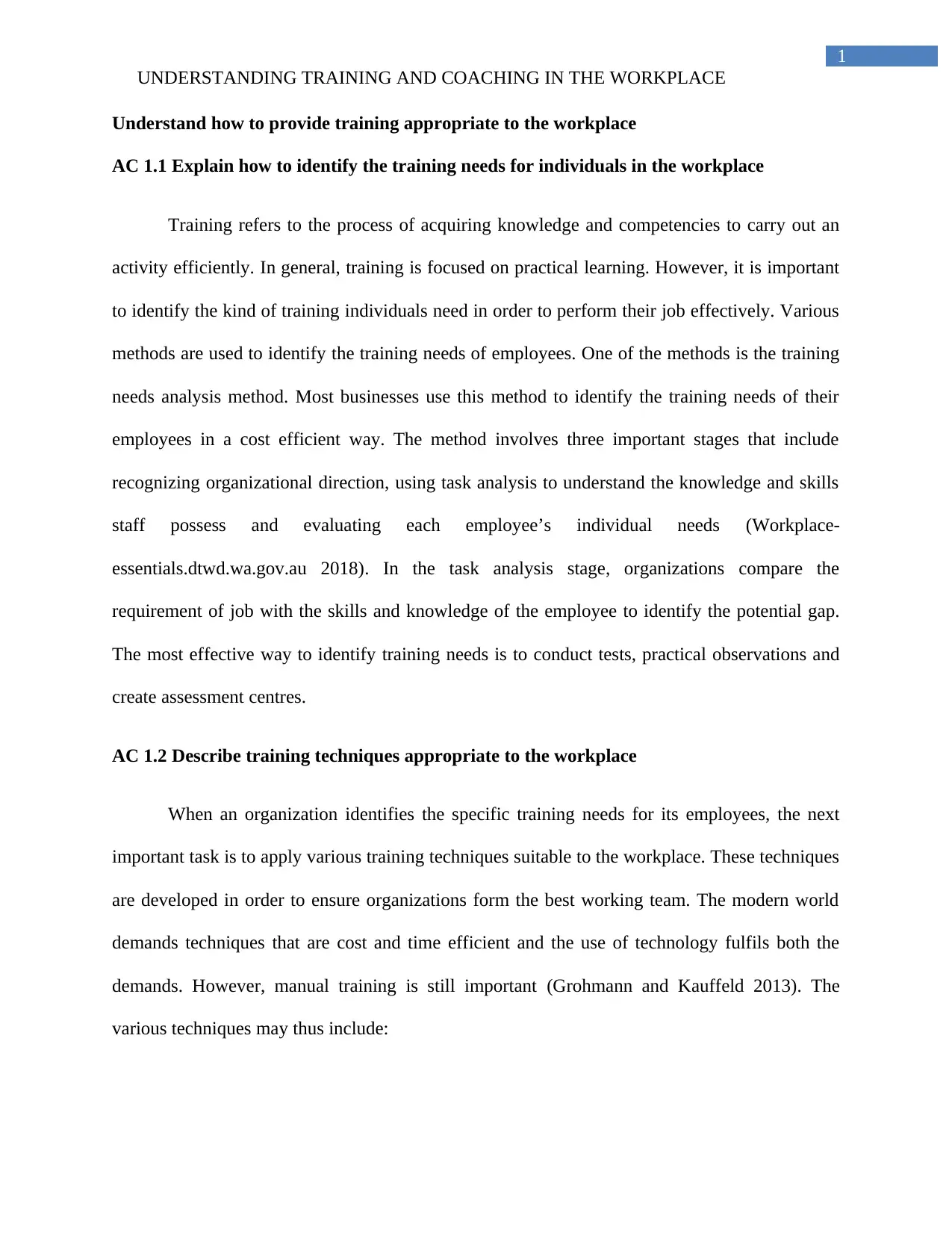
1
UNDERSTANDING TRAINING AND COACHING IN THE WORKPLACE
Understand how to provide training appropriate to the workplace
AC 1.1 Explain how to identify the training needs for individuals in the workplace
Training refers to the process of acquiring knowledge and competencies to carry out an
activity efficiently. In general, training is focused on practical learning. However, it is important
to identify the kind of training individuals need in order to perform their job effectively. Various
methods are used to identify the training needs of employees. One of the methods is the training
needs analysis method. Most businesses use this method to identify the training needs of their
employees in a cost efficient way. The method involves three important stages that include
recognizing organizational direction, using task analysis to understand the knowledge and skills
staff possess and evaluating each employee’s individual needs (Workplace-
essentials.dtwd.wa.gov.au 2018). In the task analysis stage, organizations compare the
requirement of job with the skills and knowledge of the employee to identify the potential gap.
The most effective way to identify training needs is to conduct tests, practical observations and
create assessment centres.
AC 1.2 Describe training techniques appropriate to the workplace
When an organization identifies the specific training needs for its employees, the next
important task is to apply various training techniques suitable to the workplace. These techniques
are developed in order to ensure organizations form the best working team. The modern world
demands techniques that are cost and time efficient and the use of technology fulfils both the
demands. However, manual training is still important (Grohmann and Kauffeld 2013). The
various techniques may thus include:
UNDERSTANDING TRAINING AND COACHING IN THE WORKPLACE
Understand how to provide training appropriate to the workplace
AC 1.1 Explain how to identify the training needs for individuals in the workplace
Training refers to the process of acquiring knowledge and competencies to carry out an
activity efficiently. In general, training is focused on practical learning. However, it is important
to identify the kind of training individuals need in order to perform their job effectively. Various
methods are used to identify the training needs of employees. One of the methods is the training
needs analysis method. Most businesses use this method to identify the training needs of their
employees in a cost efficient way. The method involves three important stages that include
recognizing organizational direction, using task analysis to understand the knowledge and skills
staff possess and evaluating each employee’s individual needs (Workplace-
essentials.dtwd.wa.gov.au 2018). In the task analysis stage, organizations compare the
requirement of job with the skills and knowledge of the employee to identify the potential gap.
The most effective way to identify training needs is to conduct tests, practical observations and
create assessment centres.
AC 1.2 Describe training techniques appropriate to the workplace
When an organization identifies the specific training needs for its employees, the next
important task is to apply various training techniques suitable to the workplace. These techniques
are developed in order to ensure organizations form the best working team. The modern world
demands techniques that are cost and time efficient and the use of technology fulfils both the
demands. However, manual training is still important (Grohmann and Kauffeld 2013). The
various techniques may thus include:
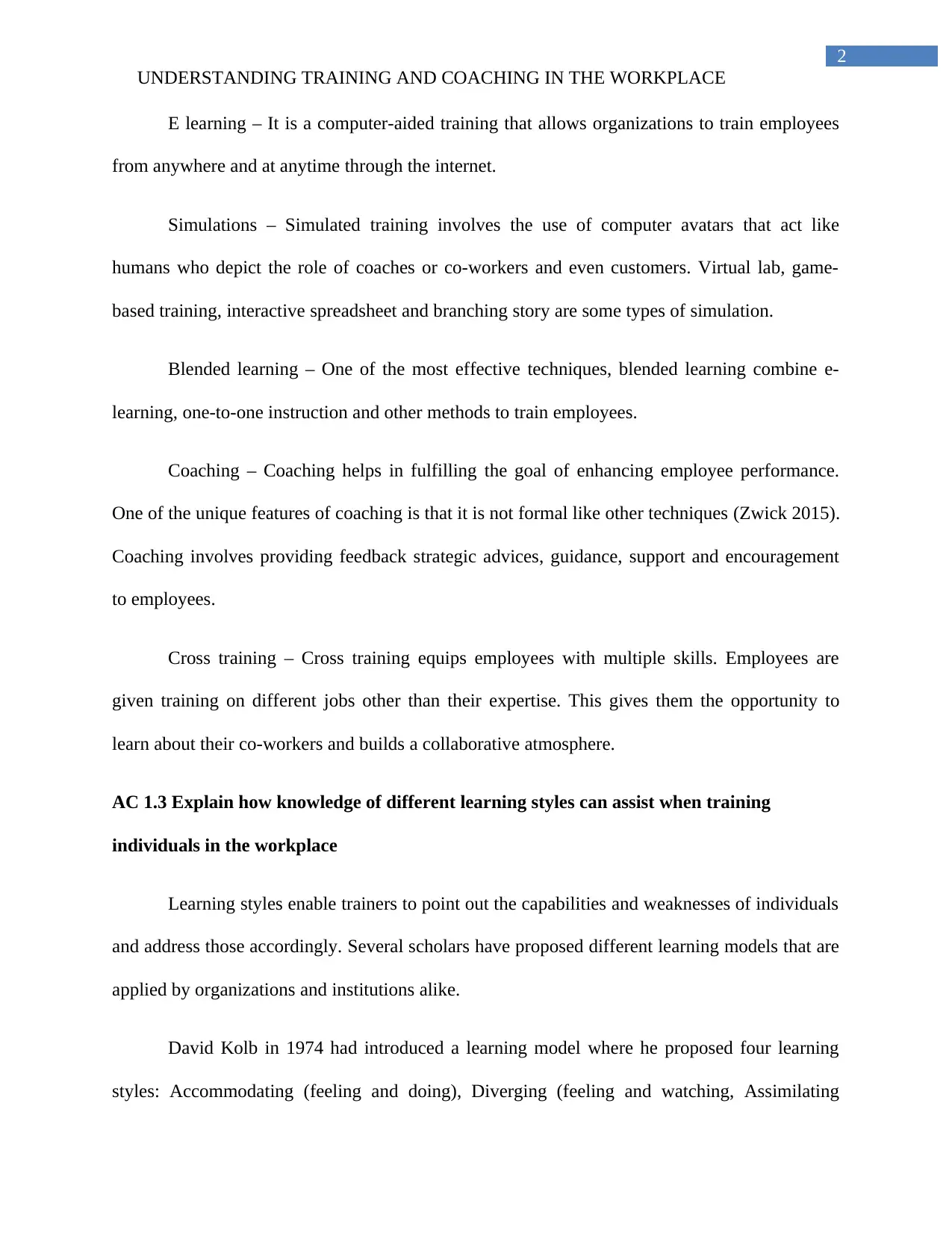
2
UNDERSTANDING TRAINING AND COACHING IN THE WORKPLACE
E learning – It is a computer-aided training that allows organizations to train employees
from anywhere and at anytime through the internet.
Simulations – Simulated training involves the use of computer avatars that act like
humans who depict the role of coaches or co-workers and even customers. Virtual lab, game-
based training, interactive spreadsheet and branching story are some types of simulation.
Blended learning – One of the most effective techniques, blended learning combine e-
learning, one-to-one instruction and other methods to train employees.
Coaching – Coaching helps in fulfilling the goal of enhancing employee performance.
One of the unique features of coaching is that it is not formal like other techniques (Zwick 2015).
Coaching involves providing feedback strategic advices, guidance, support and encouragement
to employees.
Cross training – Cross training equips employees with multiple skills. Employees are
given training on different jobs other than their expertise. This gives them the opportunity to
learn about their co-workers and builds a collaborative atmosphere.
AC 1.3 Explain how knowledge of different learning styles can assist when training
individuals in the workplace
Learning styles enable trainers to point out the capabilities and weaknesses of individuals
and address those accordingly. Several scholars have proposed different learning models that are
applied by organizations and institutions alike.
David Kolb in 1974 had introduced a learning model where he proposed four learning
styles: Accommodating (feeling and doing), Diverging (feeling and watching, Assimilating
UNDERSTANDING TRAINING AND COACHING IN THE WORKPLACE
E learning – It is a computer-aided training that allows organizations to train employees
from anywhere and at anytime through the internet.
Simulations – Simulated training involves the use of computer avatars that act like
humans who depict the role of coaches or co-workers and even customers. Virtual lab, game-
based training, interactive spreadsheet and branching story are some types of simulation.
Blended learning – One of the most effective techniques, blended learning combine e-
learning, one-to-one instruction and other methods to train employees.
Coaching – Coaching helps in fulfilling the goal of enhancing employee performance.
One of the unique features of coaching is that it is not formal like other techniques (Zwick 2015).
Coaching involves providing feedback strategic advices, guidance, support and encouragement
to employees.
Cross training – Cross training equips employees with multiple skills. Employees are
given training on different jobs other than their expertise. This gives them the opportunity to
learn about their co-workers and builds a collaborative atmosphere.
AC 1.3 Explain how knowledge of different learning styles can assist when training
individuals in the workplace
Learning styles enable trainers to point out the capabilities and weaknesses of individuals
and address those accordingly. Several scholars have proposed different learning models that are
applied by organizations and institutions alike.
David Kolb in 1974 had introduced a learning model where he proposed four learning
styles: Accommodating (feeling and doing), Diverging (feeling and watching, Assimilating
⊘ This is a preview!⊘
Do you want full access?
Subscribe today to unlock all pages.

Trusted by 1+ million students worldwide
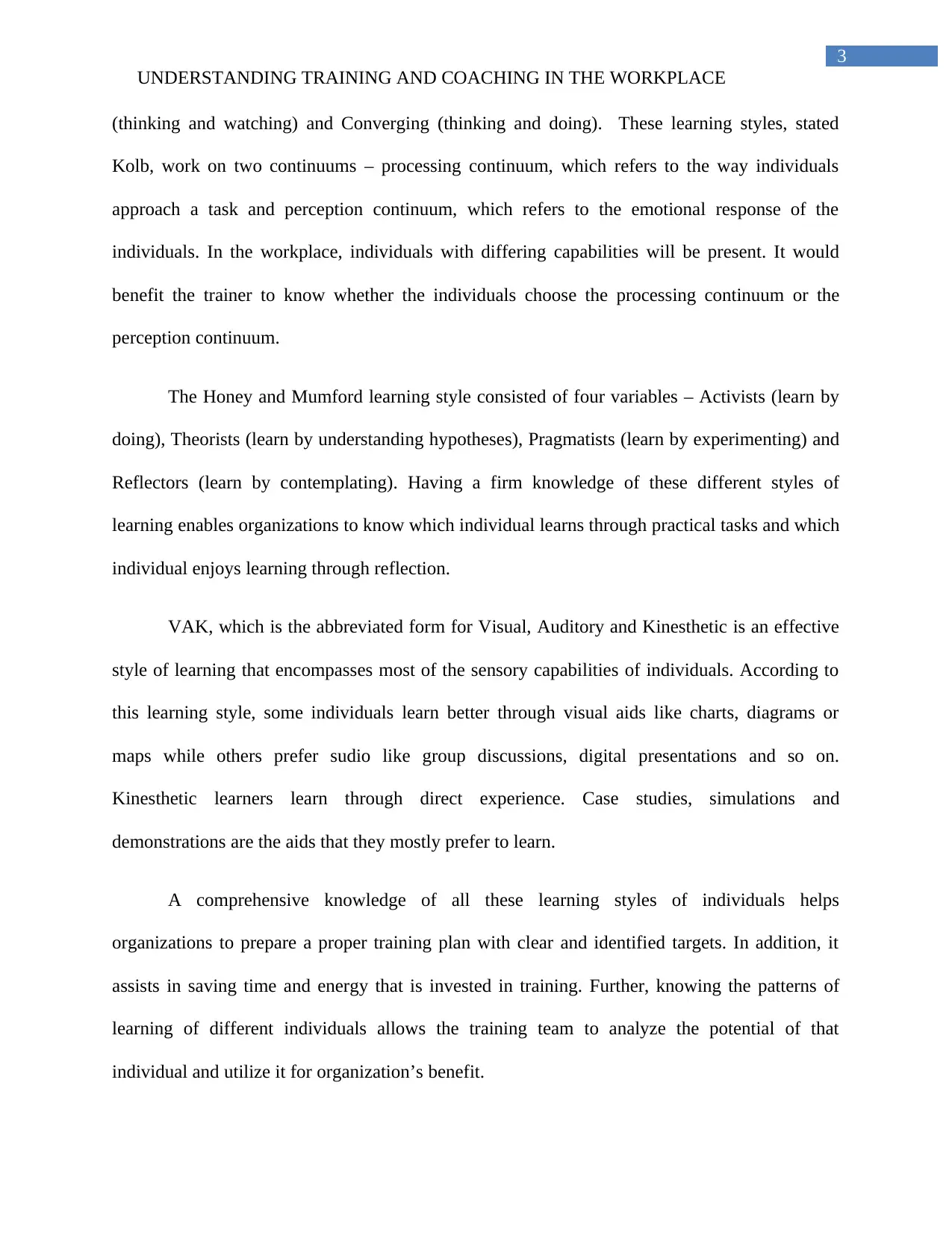
3
UNDERSTANDING TRAINING AND COACHING IN THE WORKPLACE
(thinking and watching) and Converging (thinking and doing). These learning styles, stated
Kolb, work on two continuums – processing continuum, which refers to the way individuals
approach a task and perception continuum, which refers to the emotional response of the
individuals. In the workplace, individuals with differing capabilities will be present. It would
benefit the trainer to know whether the individuals choose the processing continuum or the
perception continuum.
The Honey and Mumford learning style consisted of four variables – Activists (learn by
doing), Theorists (learn by understanding hypotheses), Pragmatists (learn by experimenting) and
Reflectors (learn by contemplating). Having a firm knowledge of these different styles of
learning enables organizations to know which individual learns through practical tasks and which
individual enjoys learning through reflection.
VAK, which is the abbreviated form for Visual, Auditory and Kinesthetic is an effective
style of learning that encompasses most of the sensory capabilities of individuals. According to
this learning style, some individuals learn better through visual aids like charts, diagrams or
maps while others prefer sudio like group discussions, digital presentations and so on.
Kinesthetic learners learn through direct experience. Case studies, simulations and
demonstrations are the aids that they mostly prefer to learn.
A comprehensive knowledge of all these learning styles of individuals helps
organizations to prepare a proper training plan with clear and identified targets. In addition, it
assists in saving time and energy that is invested in training. Further, knowing the patterns of
learning of different individuals allows the training team to analyze the potential of that
individual and utilize it for organization’s benefit.
UNDERSTANDING TRAINING AND COACHING IN THE WORKPLACE
(thinking and watching) and Converging (thinking and doing). These learning styles, stated
Kolb, work on two continuums – processing continuum, which refers to the way individuals
approach a task and perception continuum, which refers to the emotional response of the
individuals. In the workplace, individuals with differing capabilities will be present. It would
benefit the trainer to know whether the individuals choose the processing continuum or the
perception continuum.
The Honey and Mumford learning style consisted of four variables – Activists (learn by
doing), Theorists (learn by understanding hypotheses), Pragmatists (learn by experimenting) and
Reflectors (learn by contemplating). Having a firm knowledge of these different styles of
learning enables organizations to know which individual learns through practical tasks and which
individual enjoys learning through reflection.
VAK, which is the abbreviated form for Visual, Auditory and Kinesthetic is an effective
style of learning that encompasses most of the sensory capabilities of individuals. According to
this learning style, some individuals learn better through visual aids like charts, diagrams or
maps while others prefer sudio like group discussions, digital presentations and so on.
Kinesthetic learners learn through direct experience. Case studies, simulations and
demonstrations are the aids that they mostly prefer to learn.
A comprehensive knowledge of all these learning styles of individuals helps
organizations to prepare a proper training plan with clear and identified targets. In addition, it
assists in saving time and energy that is invested in training. Further, knowing the patterns of
learning of different individuals allows the training team to analyze the potential of that
individual and utilize it for organization’s benefit.
Paraphrase This Document
Need a fresh take? Get an instant paraphrase of this document with our AI Paraphraser
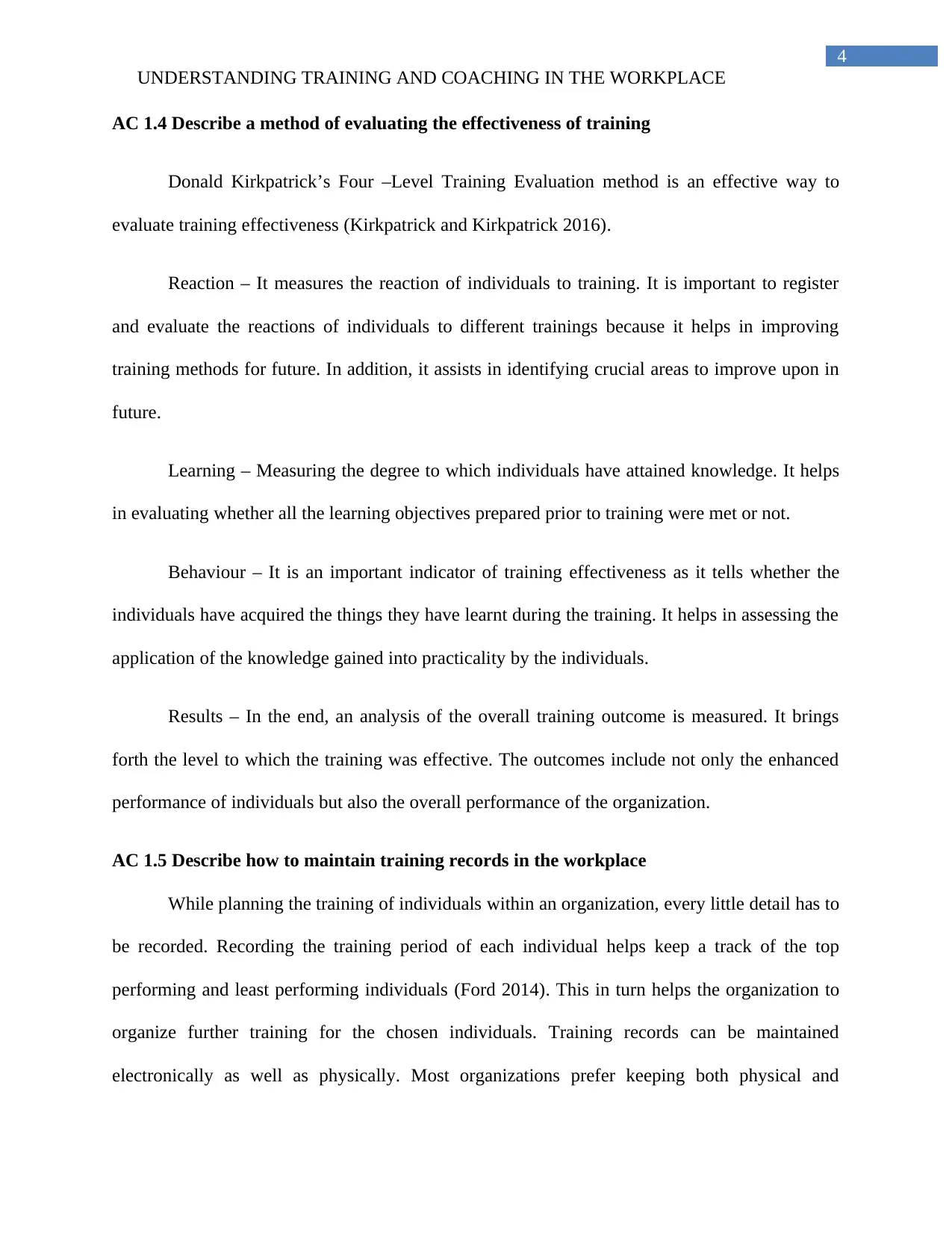
4
UNDERSTANDING TRAINING AND COACHING IN THE WORKPLACE
AC 1.4 Describe a method of evaluating the effectiveness of training
Donald Kirkpatrick’s Four –Level Training Evaluation method is an effective way to
evaluate training effectiveness (Kirkpatrick and Kirkpatrick 2016).
Reaction – It measures the reaction of individuals to training. It is important to register
and evaluate the reactions of individuals to different trainings because it helps in improving
training methods for future. In addition, it assists in identifying crucial areas to improve upon in
future.
Learning – Measuring the degree to which individuals have attained knowledge. It helps
in evaluating whether all the learning objectives prepared prior to training were met or not.
Behaviour – It is an important indicator of training effectiveness as it tells whether the
individuals have acquired the things they have learnt during the training. It helps in assessing the
application of the knowledge gained into practicality by the individuals.
Results – In the end, an analysis of the overall training outcome is measured. It brings
forth the level to which the training was effective. The outcomes include not only the enhanced
performance of individuals but also the overall performance of the organization.
AC 1.5 Describe how to maintain training records in the workplace
While planning the training of individuals within an organization, every little detail has to
be recorded. Recording the training period of each individual helps keep a track of the top
performing and least performing individuals (Ford 2014). This in turn helps the organization to
organize further training for the chosen individuals. Training records can be maintained
electronically as well as physically. Most organizations prefer keeping both physical and
UNDERSTANDING TRAINING AND COACHING IN THE WORKPLACE
AC 1.4 Describe a method of evaluating the effectiveness of training
Donald Kirkpatrick’s Four –Level Training Evaluation method is an effective way to
evaluate training effectiveness (Kirkpatrick and Kirkpatrick 2016).
Reaction – It measures the reaction of individuals to training. It is important to register
and evaluate the reactions of individuals to different trainings because it helps in improving
training methods for future. In addition, it assists in identifying crucial areas to improve upon in
future.
Learning – Measuring the degree to which individuals have attained knowledge. It helps
in evaluating whether all the learning objectives prepared prior to training were met or not.
Behaviour – It is an important indicator of training effectiveness as it tells whether the
individuals have acquired the things they have learnt during the training. It helps in assessing the
application of the knowledge gained into practicality by the individuals.
Results – In the end, an analysis of the overall training outcome is measured. It brings
forth the level to which the training was effective. The outcomes include not only the enhanced
performance of individuals but also the overall performance of the organization.
AC 1.5 Describe how to maintain training records in the workplace
While planning the training of individuals within an organization, every little detail has to
be recorded. Recording the training period of each individual helps keep a track of the top
performing and least performing individuals (Ford 2014). This in turn helps the organization to
organize further training for the chosen individuals. Training records can be maintained
electronically as well as physically. Most organizations prefer keeping both physical and
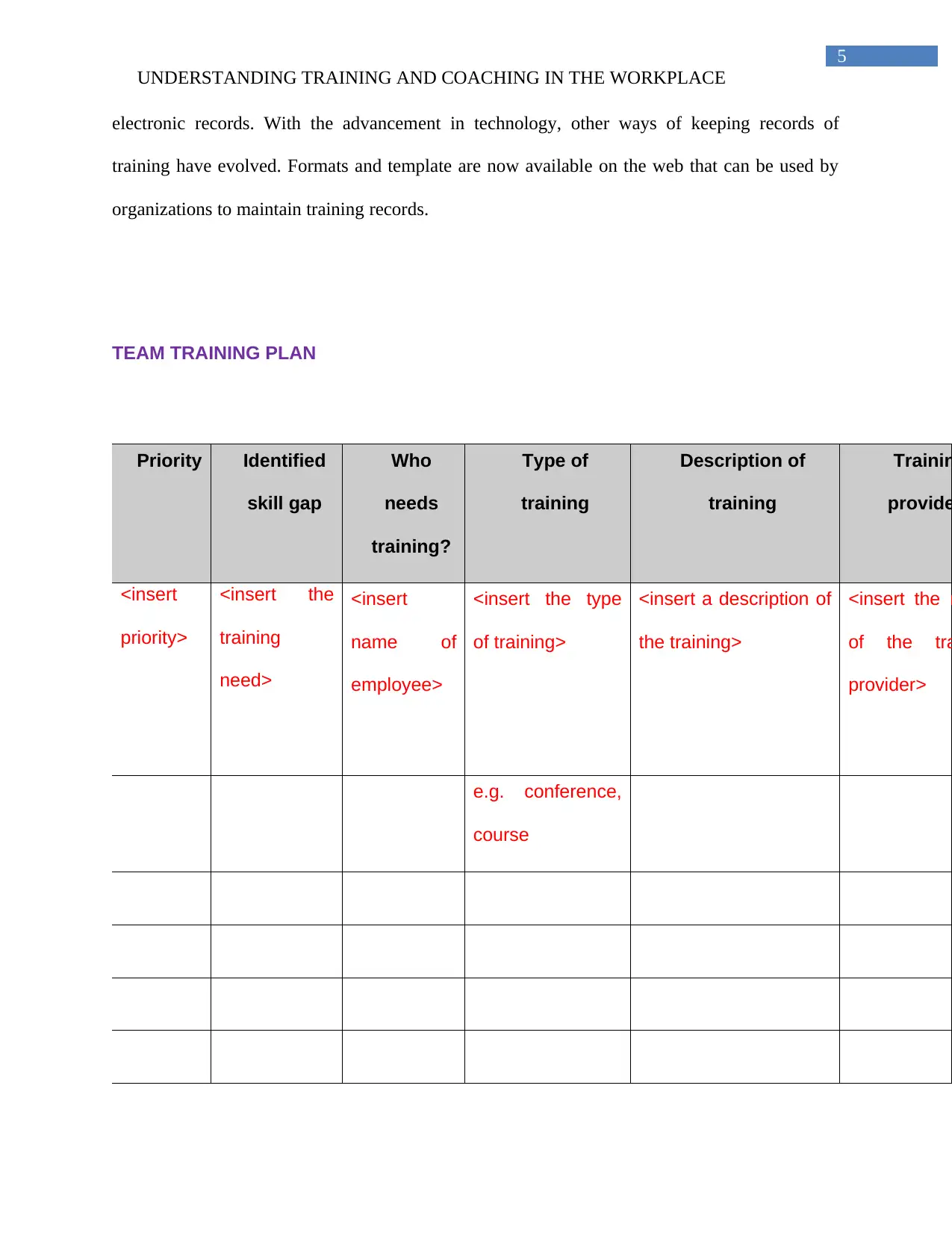
5
UNDERSTANDING TRAINING AND COACHING IN THE WORKPLACE
electronic records. With the advancement in technology, other ways of keeping records of
training have evolved. Formats and template are now available on the web that can be used by
organizations to maintain training records.
TEAM TRAINING PLAN
Priority Identified
skill gap
Who
needs
training?
Type of
training
Description of
training
Trainin
provide
<insert
priority>
<insert the
training
need>
<insert
name of
employee>
<insert the type
of training>
<insert a description of
the training>
<insert the n
of the tra
provider>
e.g. conference,
course
UNDERSTANDING TRAINING AND COACHING IN THE WORKPLACE
electronic records. With the advancement in technology, other ways of keeping records of
training have evolved. Formats and template are now available on the web that can be used by
organizations to maintain training records.
TEAM TRAINING PLAN
Priority Identified
skill gap
Who
needs
training?
Type of
training
Description of
training
Trainin
provide
<insert
priority>
<insert the
training
need>
<insert
name of
employee>
<insert the type
of training>
<insert a description of
the training>
<insert the n
of the tra
provider>
e.g. conference,
course
⊘ This is a preview!⊘
Do you want full access?
Subscribe today to unlock all pages.

Trusted by 1+ million students worldwide
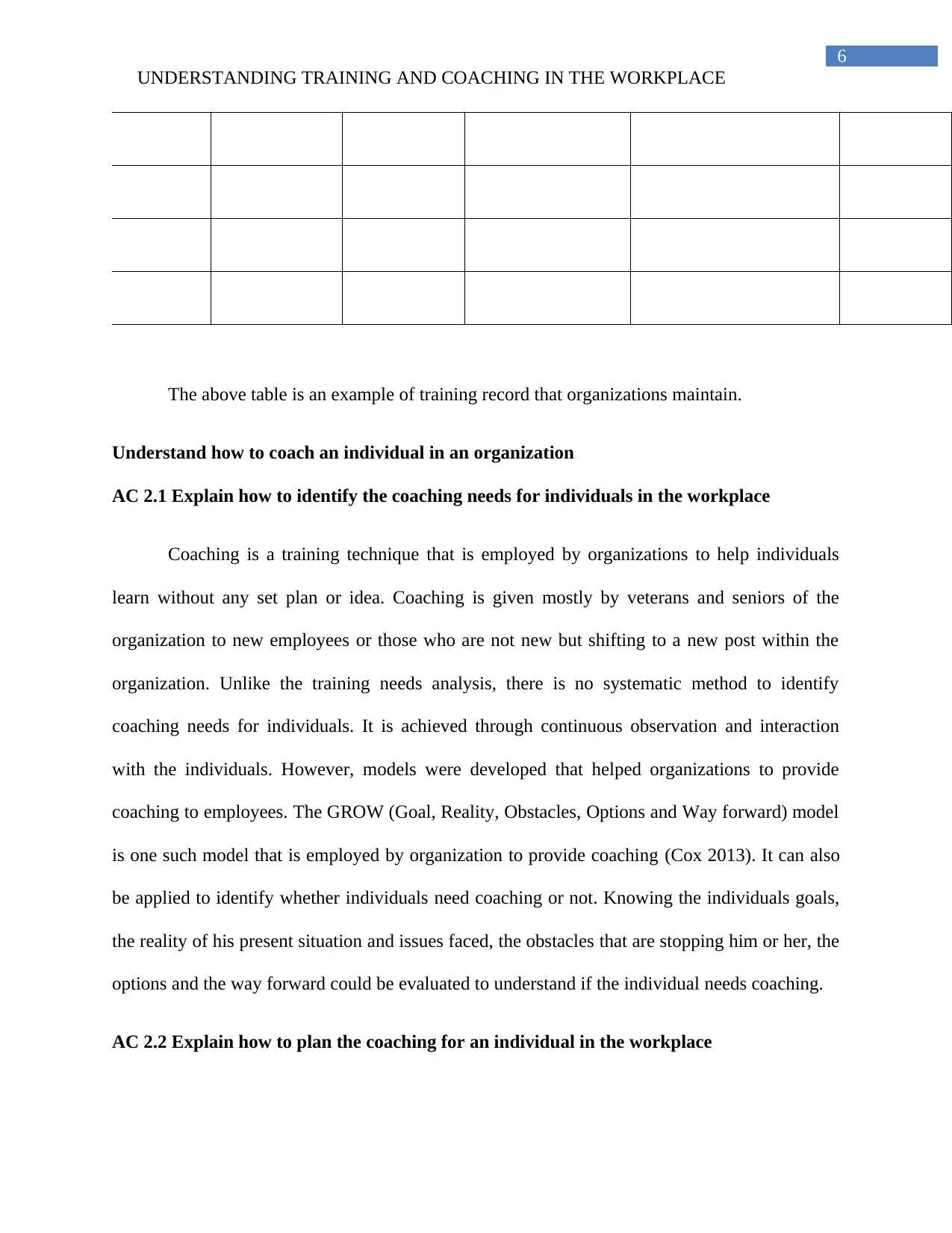
6
UNDERSTANDING TRAINING AND COACHING IN THE WORKPLACE
The above table is an example of training record that organizations maintain.
Understand how to coach an individual in an organization
AC 2.1 Explain how to identify the coaching needs for individuals in the workplace
Coaching is a training technique that is employed by organizations to help individuals
learn without any set plan or idea. Coaching is given mostly by veterans and seniors of the
organization to new employees or those who are not new but shifting to a new post within the
organization. Unlike the training needs analysis, there is no systematic method to identify
coaching needs for individuals. It is achieved through continuous observation and interaction
with the individuals. However, models were developed that helped organizations to provide
coaching to employees. The GROW (Goal, Reality, Obstacles, Options and Way forward) model
is one such model that is employed by organization to provide coaching (Cox 2013). It can also
be applied to identify whether individuals need coaching or not. Knowing the individuals goals,
the reality of his present situation and issues faced, the obstacles that are stopping him or her, the
options and the way forward could be evaluated to understand if the individual needs coaching.
AC 2.2 Explain how to plan the coaching for an individual in the workplace
UNDERSTANDING TRAINING AND COACHING IN THE WORKPLACE
The above table is an example of training record that organizations maintain.
Understand how to coach an individual in an organization
AC 2.1 Explain how to identify the coaching needs for individuals in the workplace
Coaching is a training technique that is employed by organizations to help individuals
learn without any set plan or idea. Coaching is given mostly by veterans and seniors of the
organization to new employees or those who are not new but shifting to a new post within the
organization. Unlike the training needs analysis, there is no systematic method to identify
coaching needs for individuals. It is achieved through continuous observation and interaction
with the individuals. However, models were developed that helped organizations to provide
coaching to employees. The GROW (Goal, Reality, Obstacles, Options and Way forward) model
is one such model that is employed by organization to provide coaching (Cox 2013). It can also
be applied to identify whether individuals need coaching or not. Knowing the individuals goals,
the reality of his present situation and issues faced, the obstacles that are stopping him or her, the
options and the way forward could be evaluated to understand if the individual needs coaching.
AC 2.2 Explain how to plan the coaching for an individual in the workplace
Paraphrase This Document
Need a fresh take? Get an instant paraphrase of this document with our AI Paraphraser
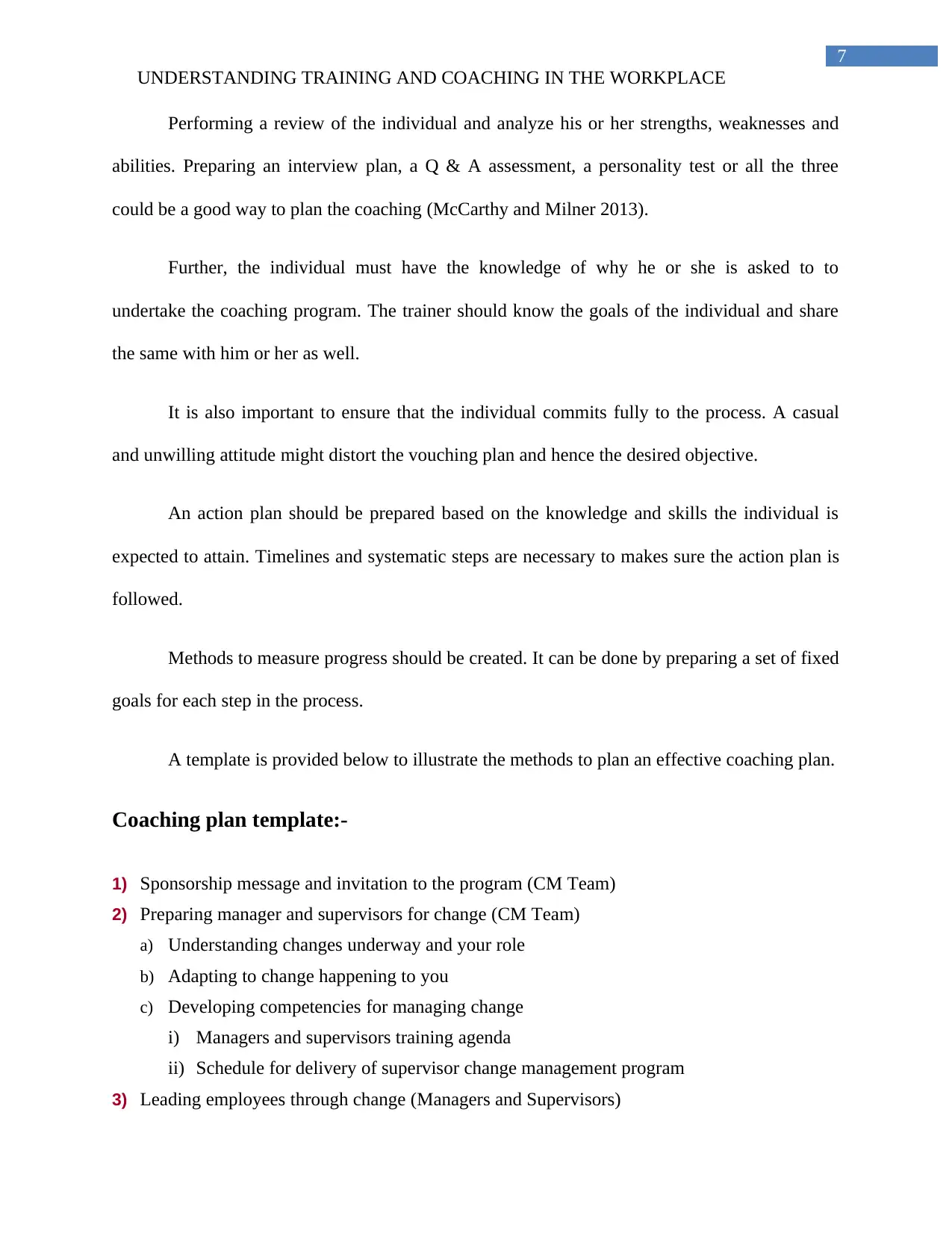
7
UNDERSTANDING TRAINING AND COACHING IN THE WORKPLACE
Performing a review of the individual and analyze his or her strengths, weaknesses and
abilities. Preparing an interview plan, a Q & A assessment, a personality test or all the three
could be a good way to plan the coaching (McCarthy and Milner 2013).
Further, the individual must have the knowledge of why he or she is asked to to
undertake the coaching program. The trainer should know the goals of the individual and share
the same with him or her as well.
It is also important to ensure that the individual commits fully to the process. A casual
and unwilling attitude might distort the vouching plan and hence the desired objective.
An action plan should be prepared based on the knowledge and skills the individual is
expected to attain. Timelines and systematic steps are necessary to makes sure the action plan is
followed.
Methods to measure progress should be created. It can be done by preparing a set of fixed
goals for each step in the process.
A template is provided below to illustrate the methods to plan an effective coaching plan.
Coaching plan template:-
1) Sponsorship message and invitation to the program (CM Team)
2) Preparing manager and supervisors for change (CM Team)
a) Understanding changes underway and your role
b) Adapting to change happening to you
c) Developing competencies for managing change
i) Managers and supervisors training agenda
ii) Schedule for delivery of supervisor change management program
3) Leading employees through change (Managers and Supervisors)
UNDERSTANDING TRAINING AND COACHING IN THE WORKPLACE
Performing a review of the individual and analyze his or her strengths, weaknesses and
abilities. Preparing an interview plan, a Q & A assessment, a personality test or all the three
could be a good way to plan the coaching (McCarthy and Milner 2013).
Further, the individual must have the knowledge of why he or she is asked to to
undertake the coaching program. The trainer should know the goals of the individual and share
the same with him or her as well.
It is also important to ensure that the individual commits fully to the process. A casual
and unwilling attitude might distort the vouching plan and hence the desired objective.
An action plan should be prepared based on the knowledge and skills the individual is
expected to attain. Timelines and systematic steps are necessary to makes sure the action plan is
followed.
Methods to measure progress should be created. It can be done by preparing a set of fixed
goals for each step in the process.
A template is provided below to illustrate the methods to plan an effective coaching plan.
Coaching plan template:-
1) Sponsorship message and invitation to the program (CM Team)
2) Preparing manager and supervisors for change (CM Team)
a) Understanding changes underway and your role
b) Adapting to change happening to you
c) Developing competencies for managing change
i) Managers and supervisors training agenda
ii) Schedule for delivery of supervisor change management program
3) Leading employees through change (Managers and Supervisors)
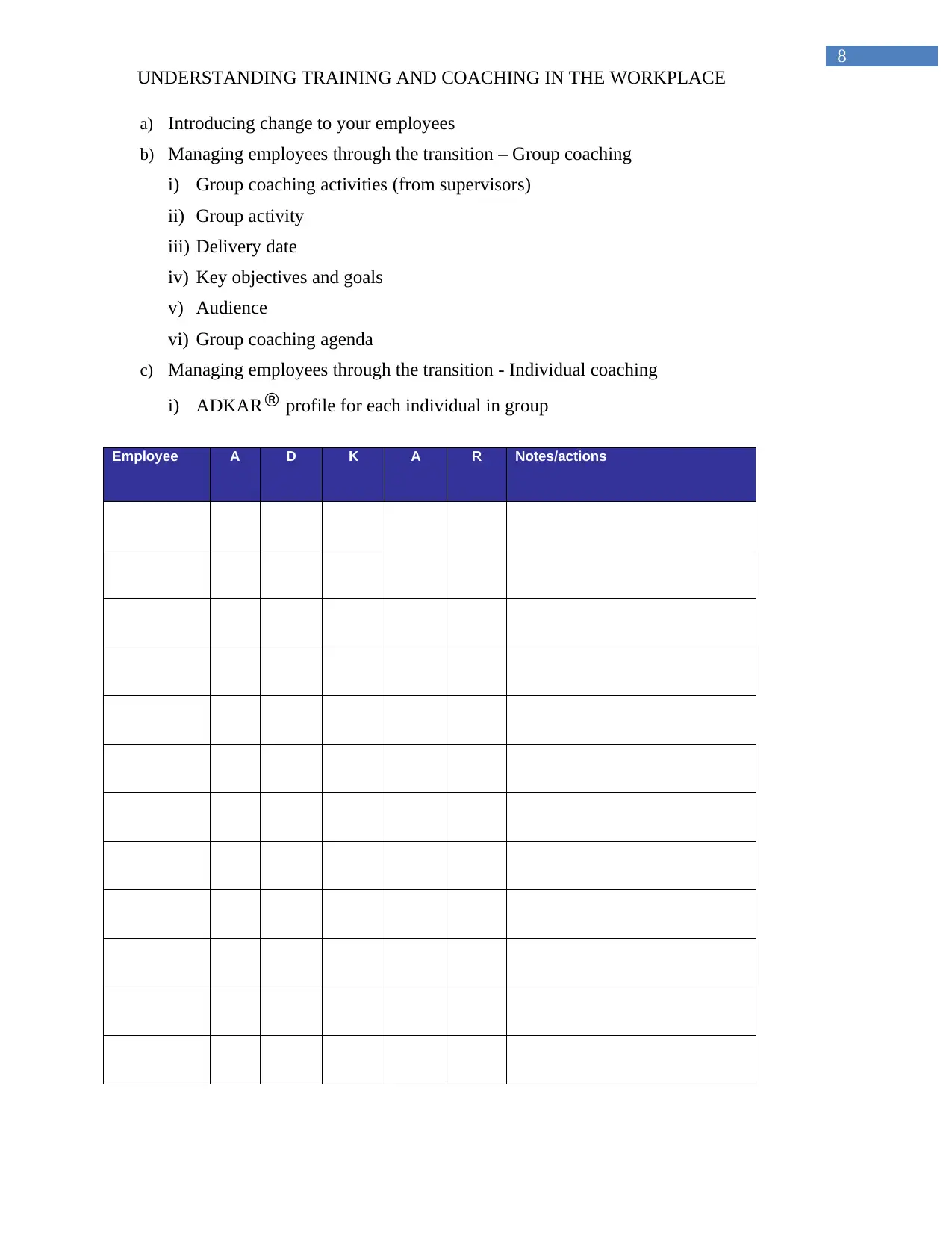
8
UNDERSTANDING TRAINING AND COACHING IN THE WORKPLACE
a) Introducing change to your employees
b) Managing employees through the transition – Group coaching
i) Group coaching activities (from supervisors)
ii) Group activity
iii) Delivery date
iv) Key objectives and goals
v) Audience
vi) Group coaching agenda
c) Managing employees through the transition - Individual coaching
i) ADKAR® profile for each individual in group
Employee A D K A R Notes/actions
UNDERSTANDING TRAINING AND COACHING IN THE WORKPLACE
a) Introducing change to your employees
b) Managing employees through the transition – Group coaching
i) Group coaching activities (from supervisors)
ii) Group activity
iii) Delivery date
iv) Key objectives and goals
v) Audience
vi) Group coaching agenda
c) Managing employees through the transition - Individual coaching
i) ADKAR® profile for each individual in group
Employee A D K A R Notes/actions
⊘ This is a preview!⊘
Do you want full access?
Subscribe today to unlock all pages.

Trusted by 1+ million students worldwide
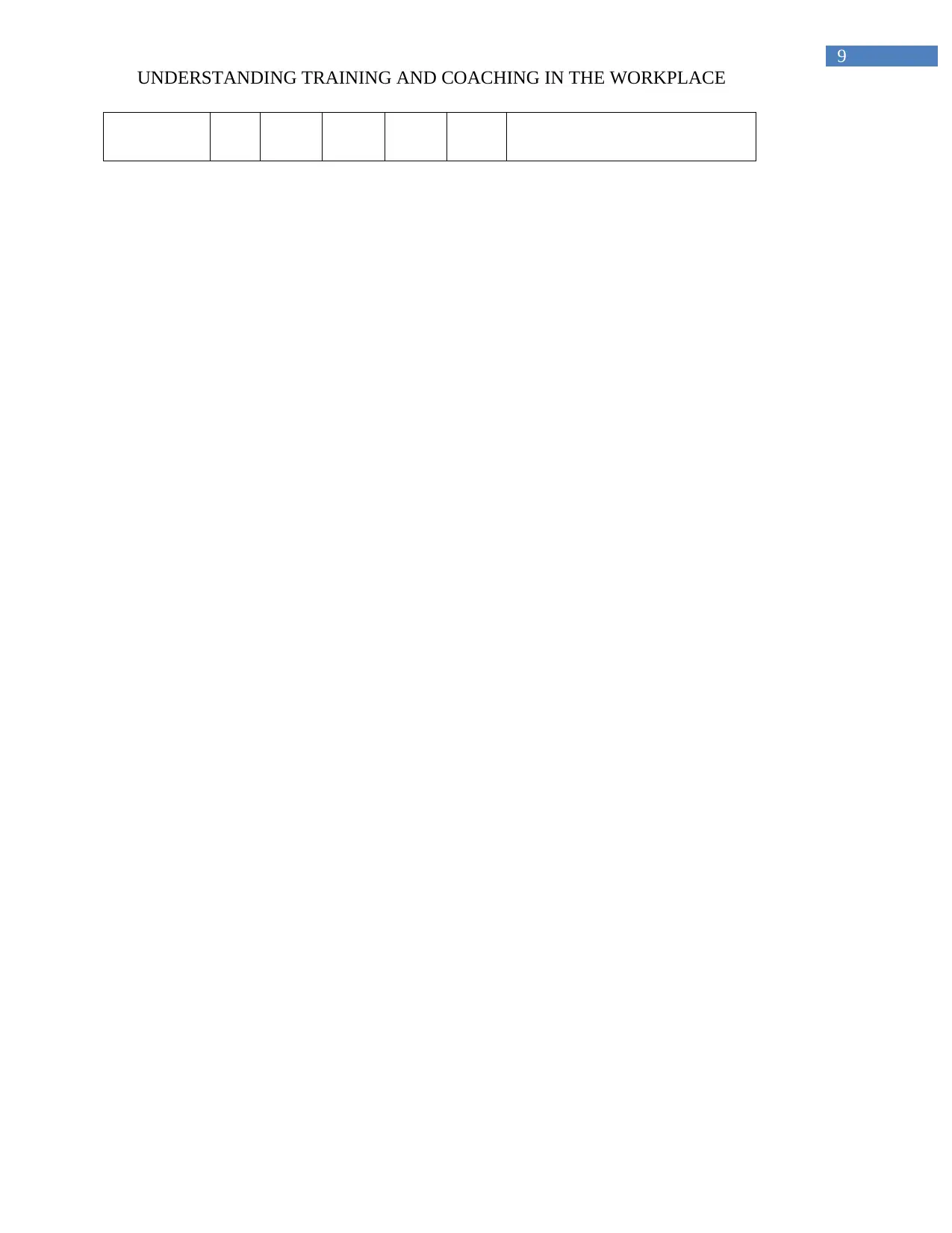
9
UNDERSTANDING TRAINING AND COACHING IN THE WORKPLACE
UNDERSTANDING TRAINING AND COACHING IN THE WORKPLACE
Paraphrase This Document
Need a fresh take? Get an instant paraphrase of this document with our AI Paraphraser
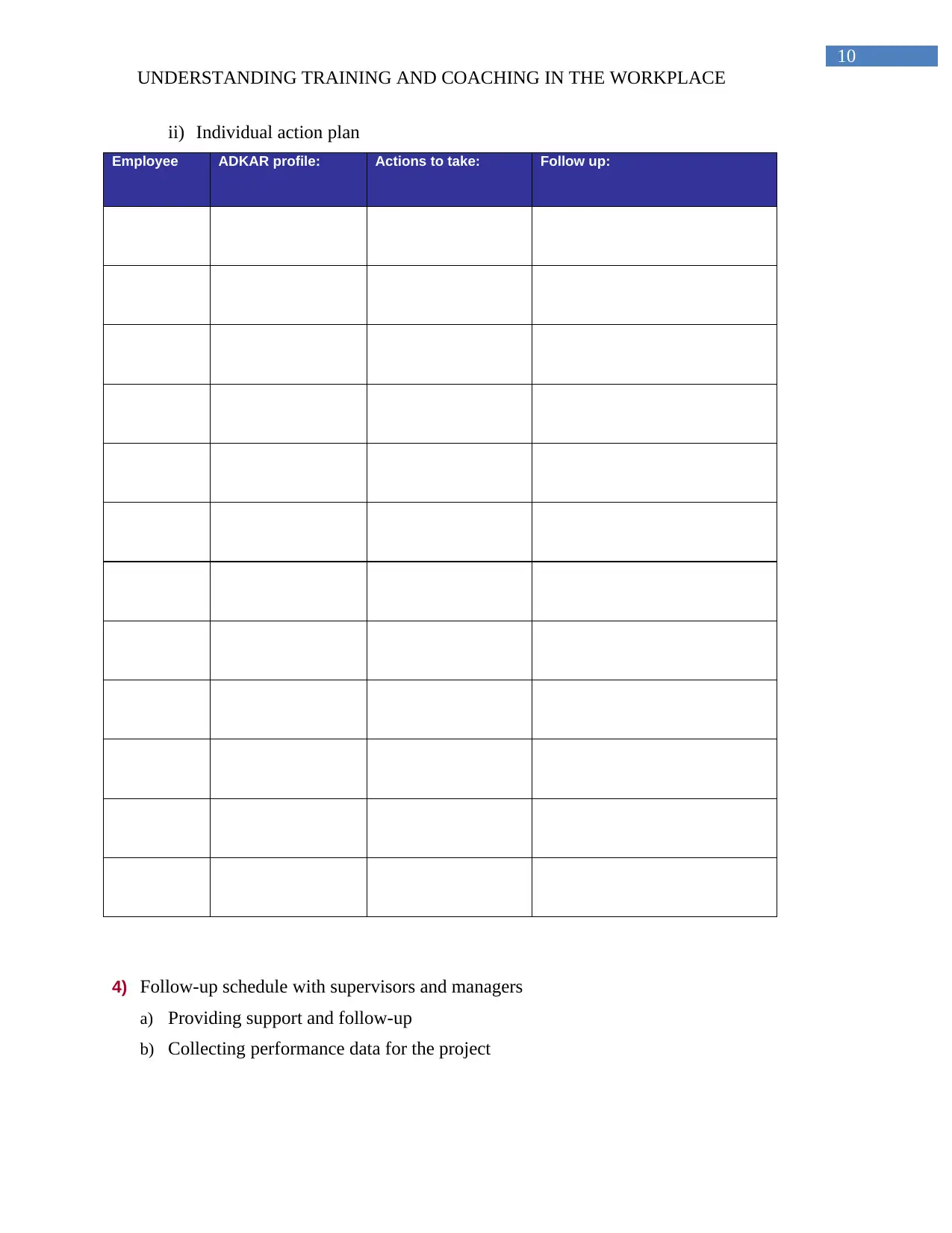
10
UNDERSTANDING TRAINING AND COACHING IN THE WORKPLACE
ii) Individual action plan
Employee ADKAR profile: Actions to take: Follow up:
4) Follow-up schedule with supervisors and managers
a) Providing support and follow-up
b) Collecting performance data for the project
UNDERSTANDING TRAINING AND COACHING IN THE WORKPLACE
ii) Individual action plan
Employee ADKAR profile: Actions to take: Follow up:
4) Follow-up schedule with supervisors and managers
a) Providing support and follow-up
b) Collecting performance data for the project
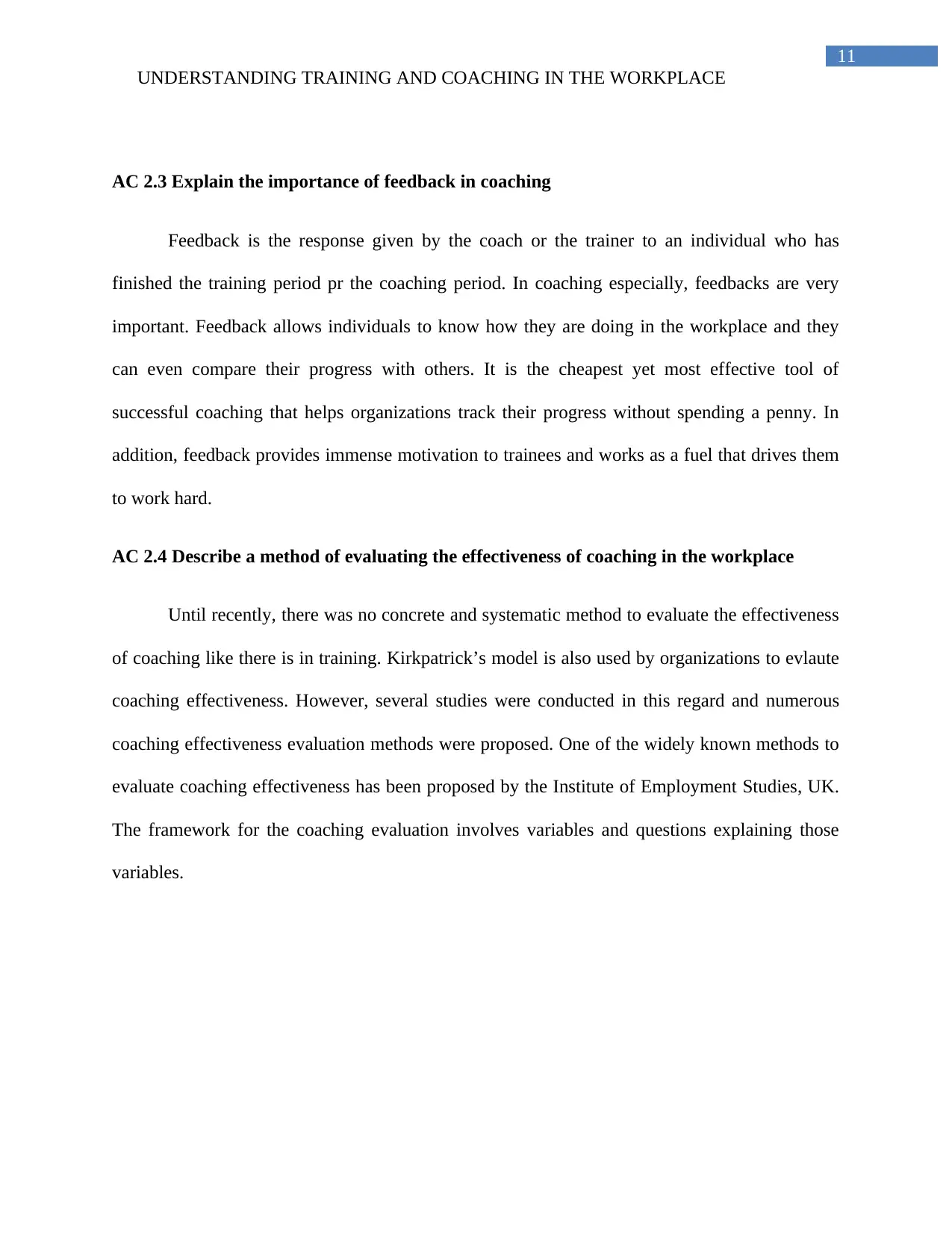
11
UNDERSTANDING TRAINING AND COACHING IN THE WORKPLACE
AC 2.3 Explain the importance of feedback in coaching
Feedback is the response given by the coach or the trainer to an individual who has
finished the training period pr the coaching period. In coaching especially, feedbacks are very
important. Feedback allows individuals to know how they are doing in the workplace and they
can even compare their progress with others. It is the cheapest yet most effective tool of
successful coaching that helps organizations track their progress without spending a penny. In
addition, feedback provides immense motivation to trainees and works as a fuel that drives them
to work hard.
AC 2.4 Describe a method of evaluating the effectiveness of coaching in the workplace
Until recently, there was no concrete and systematic method to evaluate the effectiveness
of coaching like there is in training. Kirkpatrick’s model is also used by organizations to evlaute
coaching effectiveness. However, several studies were conducted in this regard and numerous
coaching effectiveness evaluation methods were proposed. One of the widely known methods to
evaluate coaching effectiveness has been proposed by the Institute of Employment Studies, UK.
The framework for the coaching evaluation involves variables and questions explaining those
variables.
UNDERSTANDING TRAINING AND COACHING IN THE WORKPLACE
AC 2.3 Explain the importance of feedback in coaching
Feedback is the response given by the coach or the trainer to an individual who has
finished the training period pr the coaching period. In coaching especially, feedbacks are very
important. Feedback allows individuals to know how they are doing in the workplace and they
can even compare their progress with others. It is the cheapest yet most effective tool of
successful coaching that helps organizations track their progress without spending a penny. In
addition, feedback provides immense motivation to trainees and works as a fuel that drives them
to work hard.
AC 2.4 Describe a method of evaluating the effectiveness of coaching in the workplace
Until recently, there was no concrete and systematic method to evaluate the effectiveness
of coaching like there is in training. Kirkpatrick’s model is also used by organizations to evlaute
coaching effectiveness. However, several studies were conducted in this regard and numerous
coaching effectiveness evaluation methods were proposed. One of the widely known methods to
evaluate coaching effectiveness has been proposed by the Institute of Employment Studies, UK.
The framework for the coaching evaluation involves variables and questions explaining those
variables.
⊘ This is a preview!⊘
Do you want full access?
Subscribe today to unlock all pages.

Trusted by 1+ million students worldwide
1 out of 15
Related Documents
Your All-in-One AI-Powered Toolkit for Academic Success.
+13062052269
info@desklib.com
Available 24*7 on WhatsApp / Email
![[object Object]](/_next/static/media/star-bottom.7253800d.svg)
Unlock your academic potential
Copyright © 2020–2025 A2Z Services. All Rights Reserved. Developed and managed by ZUCOL.





